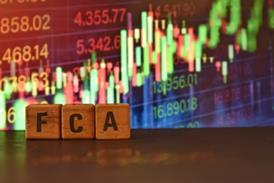Picture the scene in early 18th-century London. A building blazes while the occupants look on helplessly. Suddenly they hear wheels clattering on the rough cobbled street as a group of Thames watermen in brightly coloured uniforms races to the scene hauling hand-pulled fire pumps. Reaching the burning building they look up through the smoke to a plaque on the wall. To the owner's dismay they shake their heads and leave. Their company does not insure the building. A few minutes later, two similar groups arrive. One starts to tackle the blaze while the other stands around chatting.
Tales like this one litter the early days of fire insurance. Much of this history would be forgotten were it not for the fire marks which provide such a vivid reminder of the past.
It all started with the Great Fire of London in 1666 which spread unchecked through the entire medieval city, destroying 13,200 homes, 89 churches and the original St Paul's Cathedral. The aftermath of the fire was a bonanza for astute property developers like Dr Nicholas Barbon. Realising that an insured house was worth more than an uninsured one, he started in 1667 to insure properties himself. In 1680 others joined him and so the Fire Office, the world's first fire insurance company, was born.
Entrepreneurs and merchants soon formed competing companies, often on a mutual basis. The Friendly Society was formed in 1683, closely followed by The Hand in Hand in 1696 (which the Commercial Union took over in 1905). The Sun Fire Office started life in 1708 with the intention of just insuring contents.
As there were no public fire brigades in those days the Fire Office and many of its successors set up their own, each with a distinctive uniform. Deterring looters and protecting salvage was often as important as extinguishing fires, and many brigades were equipped with swords and batons as well as more conventional fire-fighting equipment, such as hand pumps, leather buckets, axes and ladders. The insurers eventually agreed to pay each others' brigades for fighting fires at premises they insured. The brigade which got there first usually received the most, so there was often a race to be first on the scene.
Most of the London fire brigades amalgamated in 1833 to form the London Fire Engine Establishment, but elsewhere insurers maintained their own brigades until they were either disbanded or taken over by the local authority. The last one was probably the Norwich Union's brigade in Worcester, which lasted until 1929.
Fire branding
Street numbering was patchy, so to identify which buildings were insured, the insurers fixed lead fire marks to them, usually between the upper storey windows. These marks depicted the emblem of the company and showed the firemen who would pay their fees. The Fire Office's emblem of a phoenix rising from the flames was so strong that by 1700 the company was known as “The Phenix” (not to be confused with the later Phoenix Assurance Company).
Fire marks were therefore a good form of advertising. They were probably the first designer label because the building's owner not only displayed the insurer's emblem but also paid for the privilege. Each fire mark cost around 1/2d (6p) to make but, typically, insurance companies charged their policyholders 1/8d (8.5p), so making a healthy profit.
The use of fire marks soon spread worldwide. In the US, the “Hand-in-Hand” (no relation to its British namesake) began issuing them in 1752. Russian insurers followed in 1827 and even after the 1917 Revolution, Gosstrakh, the state monopoly, continued using them as a sign of collectivist participation.
In Australia in the mid-19th century, following an outbreak of arson by unemployed sheep shearers, Norwich Union issued linen fire marks to attach to hay stacks These advertised a £100 reward for the conviction of an arsonist.
Fire-raising by disgruntled or laid-off employees was also a problem in the UK, so even after street numbering became more widespread following the introduction of the postal system in 1837, many insurers still continued to issue fire marks. Some people deliberately put a fake fire mark on their building to deter arsonists. There was little point in burning down a building if the owner had the insurance proceeds to replace it.
By the end of the 19th century the use of fire marks had virtually died out. There are a handful of later ones, but these were mainly either promotional items or plaques for use in agents' offices.
Objects of burning desire
There is a huge variety of fire marks to collect. In the UK alone, well over 100 insurers issued them with more than 500 different designs.
Genuine fire marks often sell for surprisingly little and the oldest marks are not necessarily the most expensive. A 19th century Royal Insurance Company tin fire mark depicting the company's crown and Liver bird emblem can be bought for as little as £25. A late 18th century Sun Fire Office lead mark, with its famous sun, may be only a little dearer.
The most eagerly sought-after fire marks are those in good condition, that were issued in small numbers – such as the rare, 18th century, Bristol Crown Fire Office mark which sold for £7,700. Many Scottish and Irish marks are also very valuable with prices tending to start at £1,000.
Fire marks can often be found in antique shops or at local auction houses, but the best way of acquiring a genuine one is to attend an auction held by the Fire Mark Circle. Fakes are rare at these auctions and, with the many experts on hand, news soon gets round if a forgery turns up. The circle's auction catalogue shows prices achieved at previous auctions and its rarity guide indicates how rare and desirable the fire marks are.
Faking it
Fortunately, all known fakes have some tell-tale signs. Lead fakes are usually heavier than the original. Nail holes are often round whereas the originals were invariably square. Sometimes fakes are made from the wrong type of material, for example, lead rather than copper. Some 19th century fakes are actually quite valuable in their own right.
Reproductions are easy to spot. They are often made of aluminium, cast iron or fibreglass, they normally have features, such as a tab to hang them up by, to show they are not genuine. Lead reproductions may even have the manufacturer's name or Made in England stamped on the back.
The Chartered Insurance Institute's collection of over 2,000 marks is one of the finest in the world. It spans 200 years from a 17th century Friendly Society lead mark to late Victorian copper and tin specimens.
Outside London, there are major collections at Belvoir Castle in Lincolnshire and Castle Museum, York, as well as in various municipal museums and insurance company offices. Not all the collections are on public display but they can usually be viewed by prior appointment.
There are also still a few genuine fire marks left in situ. A chance discovery of one on an old building is a rich reminder of a fascinating chapter in our social history.





































